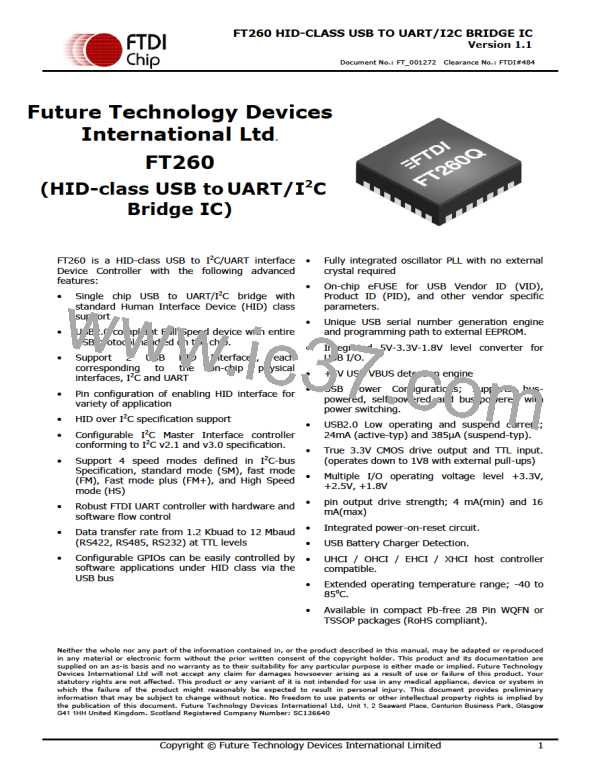FT260 HID-CLASS USB TO UART/I2C BRIDGE IC
Version 1.1
Document No.: FT_001272 Clearance No.: FTDI#484
4 Function Description
The FT260 is a USB device which supports I²C and UART communication through standard USB HID class
interfaces. The USB HID class is natively supported by most operating systems. A custom driver is not
required to be installed for the FT260.
4.1 Key Features
Highly Functional Integration. FT260 is highly integrated, with a USB2.0 compliant full-speed
transceiver, oscillator PLL as the source of the operating clock, LDO regulator for full chip operating
power source, eFUSE for basic customization and automatic scanning mechanism of EEPROM for
advanced customization. It also includes Power-On-Reset (POR) and VBUS detection input with 5V-
tolerance. These embedded functions simplify external circuit design and reduce external component
count.
HID class USB to I2C/UART Bridge. FT260 provides the bridge function between standard a USB HID
class driver and an I2C slave device and/or UART device. The standard USB HID class driver is natively
supported by most operating systems meaning the FT260, does not need a customized driver to be
installed. The USB HID class exchanges data between a host and a device by HID reports, which are the
actual data blobs follow HID format, and the application developers have to communicate with the FT260
via the HID reports. Please refer to Application Notes for detail formats. In order to help the developers,
FTDI also provides a Windows DLL with easy-to-use API for FT260 application development.
There are 2 USB interfaces corresponding to HID class in the FT260. One is for the I2C bus and the other
is for the UART bus. These two interfaces can exist concurrently and can be selected independently
according to the application. For each interface, there exists one Interrupt IN pipe and Interrupt OUT pipe
with a max packet size equal to 64 bytes. With the fastest polling frequency, one time in 1 ms, the
Interrupt pipes can operate with maximum data throughput up to 64kB/sec. Users can also utilize the
HID class commands through the Control pipe to configure the setting and to control the functions in the
FT260. Digital function pins can be programmed as GPIO and can be controlled by HID class commands
through Endpoint 0.
The I2C bus can run at common I2C bus speeds, standard mode (SM), fast mode (FM), Fast mode plus
(FM+), and High Speed mode (HS). A higher bit rate on the I2C bus is also configurable up to 3Mbit/s.
Clock stretching is supported to conform to v2.1 and v3.0 of the I2C specification. The default
configuration is for standard mode speed (SM). All the configurable settings can be changed over USB
before the I2C bus starts any transferring.
The robust FTDI UART bus is embedded in the FT260. The baud rate can be supported from 1200 baud to
12M baud. RTSN/CTSN, DSRN/DTRN and XON/XOFF handshaking options are also supported and can be
enabled by associated APIs defined in the DLL for the FT260. Data can be received from the RX pin and
delivered to the HID driver via the Interrupt IN pipe. Data can also be delivered from the USB host
through the Interrupt OUT pipe and transmitted on to the TX pin.
An remote wake up function is also supported. If the operating system supports remote wake up and
allows external hardware to wake it, the FT260 can be resumed by the pin DIO8 which is set by default
as WAKEUP triggering a resume signal on USB bus to wake up USB host. DIO11 can also be a remote
wake up source when the pin function is set as RI and the parameter, RI as Wake-Up; defined in external
EEPROM is enabled.
HID over I2C Bridge Human Interface Device (HID) is one of the most popular USB devices. It was a
protocol developed to simplify the process of connecting accessories such as mouse, keyboard and
touchpad to the PC. HID was originally developed to run over USB or Bluetooth. For Windows 8, Microsoft
created a new device type called “HID over I2C”, which allows the device to communicate HID protocol
over an Inter-Integrated Circuit (I²C) bus. The new “HID over I2C” devices are only supported natively by
Microsoft Windows 8 or above.
Copyright © Future Technology Devices International Limited
12

 FTDI [ FUTURE TECHNOLOGY DEVICES INTERNATIONAL LTD. ]
FTDI [ FUTURE TECHNOLOGY DEVICES INTERNATIONAL LTD. ]